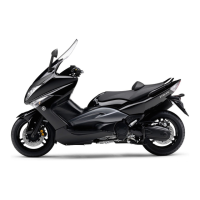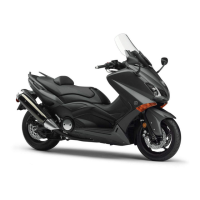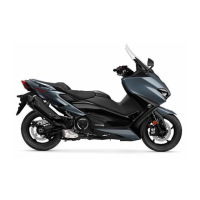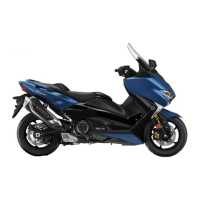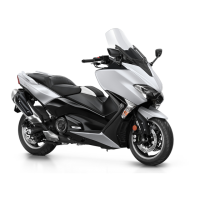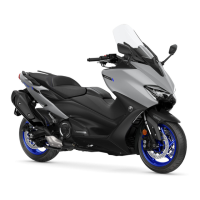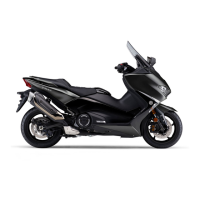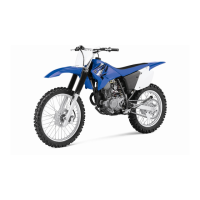Do you have a question about the Yamaha TMAX XP500F 2015 and is the answer not in the manual?
Details on vehicle identification number and model label location.
Outlines the fuel injection (FI) system and multi-function display.
Information on preparation for removal, replacement parts, and handling of various components.
Guidance on handling quick fasteners and electrical system components.
Lists special tools required for maintenance and assembly with part numbers.
Provides overall vehicle dimensions, seat height, wheelbase, and weight specifications.
Details engine type, displacement, bore, stroke, compression, fuel, and oil specifications.
Covers frame type, caster angle, trail, wheels, tires, and brake specifications.
Lists voltage, ignition system, battery, and bulb specifications for the electrical system.
Provides general, engine, and chassis tightening torque specifications for fasteners.
Details lubrication points for engine and chassis components and recommended lubricant types.
Illustrates the layout and components of the cooling system.
Provides diagrams and instructions for routing various cables and hoses on the vehicle.
Introduces the chapter and emphasizes preventive maintenance for reliability and service life.
Outlines maintenance intervals for emission control system components.
Details general maintenance checks and lubrication points with recommended intervals.
Procedure for inspecting fuel hoses for damage or leaks and ensuring proper routing.
Steps for checking, cleaning, measuring gap, and installing spark plugs.
Detailed procedure for measuring and adjusting valve clearance on a cold engine.
Steps for adjusting the engine's idling speed after warming up.
Procedure for synchronizing throttle bodies using vacuum gauges.
Steps to inspect throttle body joints for cracks or damage.
Procedure to check the cylinder head breather hose for cracks or loose connections.
Instructions for inspecting exhaust pipes and gaskets for damage or leaks.
Steps to inspect the canister and its purge hoses for damage or cracks.
Procedure for removing and replacing the air filter element.
Instructions for cleaning the V-belt case air filter elements.
Steps to check the proper functioning of both front and rear brakes.
Procedure for checking and topping up the brake fluid level.
Steps to adjust the front brake lever position for desired feel.
Procedure to check front brake pad wear indicators.
Steps to adjust the rear brake lever position for desired feel.
Procedure to check rear brake pad wear indicators.
Detailed procedure for bleeding air from the hydraulic brake system.
Instructions for inspecting front brake hoses and holders for cracks or damage.
Instructions for inspecting rear brake hoses and holders for cracks or damage.
Procedure for adjusting the rear brake lock cable length and piston.
Steps to check the operation and cable length of the rear brake lock.
Procedure for checking wheels for damage, runout, and balance.
Steps to check tire pressure, tread depth, wear indicators, and surfaces.
Procedure to check wheel bearings for looseness and smooth operation.
Checks for damage and play.
Procedure for inspecting the drive belt for cracks, missing teeth, or wear.
Detailed steps for measuring and adjusting drive belt slack using a tension gauge.
Instructions for cleaning and lubricating drive pulley and drive axle components.
Procedure for checking and adjusting steering head play and binding.
Ensures structural integrity by checking fastener tightness.
Ensures smooth lever operation by lubricating pivot points.
Checks for proper function and smooth movement.
Ensures smooth operation by lubricating pivot points and contact points.
Checks for proper function and smooth movement.
Ensures smooth operation by lubricating pivot points and contact points.
Checks a safety feature for proper operation.
Checks front fork components for proper suspension and handling.
Checks rear shock absorber operation, oil leaks, and gas leaks.
Critical for engine lubrication and life; checks and adds oil if needed.
Essential engine maintenance procedure for draining and replacing engine oil, including filter.
Checks engine lubrication health by measuring oil pressure.
Critical for engine cooling; checks coolant level in reservoir and radiator.
Checks system components for damage or leaks.
Essential cooling system maintenance procedure for draining and refilling.
Critical for transmission function; procedures for V-belt replacement.
Checks safety feature operation.
Ensures smooth cable operation by checking condition and lubricating.
Checks for smooth operation and free play; lubricates if necessary.
Ensures proper road illumination and safety by adjusting headlight beams.
Details removal and installation of windshield, front covers, and mirrors.
Procedures for removing and installing side panels, center cover, and footboards.
Removal and installation of inner panels, meter components, and leg shields.
Procedures for removing and installing rear cowling, mudguard, and fender.
Details removal and installation of the storage box and related fuel lines.
Comprehensive guide to removing, disassembling, checking, assembling, and installing the front wheel.
Procedures for removing, disassembling, checking, and installing the rear wheel and brake components.
Detailed procedures for removing, disassembling, checking, and installing front brake components.
Detailed procedures for removing, disassembling, checking, and installing rear brake components.
Instructions for removing, checking, and installing the handlebar and its controls.
Procedures for removing, disassembling, checking, assembling, and installing front fork legs.
Steps for removing, checking, and installing the steering head components.
Procedures for checking and installing the drive belt and related components.
Instructions for handling, removing, checking, and installing the rear shock absorber.
Procedures for removing, checking, installing, and lubricating the swingarm.
Procedures for measuring engine compression pressure to diagnose performance issues.
Detailed steps for removing the engine assembly from the vehicle.
Procedures for removing, checking, and installing camshafts and related components.
Steps for removing, checking, and installing the cylinder head and gasket.
Procedures for removing, checking, and installing valves, springs, seals, and guides.
Steps for removing, checking, and installing cylinders, pistons, and rings.
Procedures for removing, disassembling, checking, assembling, and installing the starter motor.
Detailed procedures for removing, checking, assembling, and installing the V-belt and sheave assemblies.
Procedures for removing, checking, and installing the generator and starter clutch components.
Procedures for removing, disassembling, checking, assembling, and installing the clutch assembly.
Steps for removing, disassembling, checking, assembling, and installing the oil pump.
Procedures for separating, checking, assembling, and cleaning the crankcase.
Procedures for removing, checking, and installing the crankshaft, connecting rods, and bearings.
Steps for removing and checking transmission gears and shafts.
Procedures for removing, checking, and installing the radiator and its related components.
Steps for removing, checking, and installing the oil cooler and its hoses.
Procedures for removing, checking, and installing the thermostat and its cover.
Procedures for removing, disassembling, checking, assembling, and installing the water pump.
Procedures for removing, checking, and installing the fuel tank and related components.
Procedures for removing, disassembling, checking, installing, and adjusting the throttle body.
Circuit diagram and troubleshooting guide for the ignition system.
Circuit diagram and troubleshooting for the electric starting system.
Circuit diagram and troubleshooting for the charging system.
Circuit diagram and troubleshooting for all lighting components.
Circuit diagram and troubleshooting for turn signals, brake lights, horn, etc.
Circuit diagram for the cooling system, including fan and sensors.
Circuit diagram, self-diagnostic functions, and troubleshooting for the FI system.
Circuit diagram and troubleshooting for the fuel pump system.
Circuit diagram, troubleshooting, and procedures for registering/disabling smart keys.
Visual identification of various electrical components used in the system.
Procedures for checking the continuity and operation of various switches.
Steps to check bulbs and sockets for damage, wear, and continuity.
Procedure for checking fuses for continuity and replacing blown fuses.
Detailed guide on checking battery charge, handling, and charging procedures.
Procedures for checking the continuity and operation of various relays.
Steps to check diodes for continuity and no continuity.
Procedure to check spark plug cap resistance for proper ignition.
Steps to measure primary and secondary coil resistance.
Procedure to check and adjust the ignition spark gap.
Steps to check sensor resistance and installation.
Procedure to check lean angle sensor output voltage.
Steps to check starter motor operation by applying battery voltage.
Procedure to measure stator coil resistance.
Checks charging voltage and stator coil condition.
Steps to check fuel sender resistance by measuring at different float positions.
Procedure to check the fuel meter and warning indicator for proper function.
Steps to check speed sensor output voltage and reading.
Procedure to check radiator fan motor operation and connections.
Steps to check coolant temperature sensor resistance and installation.
Procedure to measure throttle position sensor resistance and check its angle.
Steps to check intake air pressure sensor output voltage and connections.
Procedure to check intake air temperature sensor resistance in water.
Steps to check fuel injector resistance and connections.
Procedure to check the smart key battery voltage.
General troubleshooting guide and disclaimer.
Lists potential causes for engine starting failure or difficulty.
Potential causes for abnormal engine idling speed.
Possible reasons for poor performance at medium and high speeds.
Symptoms and causes related to clutch malfunction.
Critical for engine survival and safety; potential causes for engine overheating.
Possible causes for engine overcooling.
Critical for safety; lists potential causes for impaired braking performance.
Common issues and causes for front fork leg malfunction.
Affects vehicle control and safety; factors contributing to unstable handling.
Affects visibility and communication; troubleshooting guide for lighting and signaling system failures.
Essential for diagnosing electronic issues; reference for fault codes and procedures.
Table listing fault codes, items, and their corresponding symptoms and causes.
Troubleshooting guide for communication errors between ECU, meter, and diagnostic tool.
Table detailing sensor operation checks and expected values.
Table outlining procedures for checking actuator operation.
Details on vehicle identification number and model label location.
Outlines the fuel injection (FI) system and multi-function display.
Information on preparation for removal, replacement parts, and handling of various components.
Guidance on handling quick fasteners and electrical system components.
Lists special tools required for maintenance and assembly with part numbers.
Provides overall vehicle dimensions, seat height, wheelbase, and weight specifications.
Details engine type, displacement, bore, stroke, compression, fuel, and oil specifications.
Covers frame type, caster angle, trail, wheels, tires, and brake specifications.
Lists voltage, ignition system, battery, and bulb specifications for the electrical system.
Provides general, engine, and chassis tightening torque specifications for fasteners.
Details lubrication points for engine and chassis components and recommended lubricant types.
Illustrates the layout and components of the cooling system.
Provides diagrams and instructions for routing various cables and hoses on the vehicle.
Introduces the chapter and emphasizes preventive maintenance for reliability and service life.
Outlines maintenance intervals for emission control system components.
Details general maintenance checks and lubrication points with recommended intervals.
Procedure for inspecting fuel hoses for damage or leaks and ensuring proper routing.
Steps for checking, cleaning, measuring gap, and installing spark plugs.
Detailed procedure for measuring and adjusting valve clearance on a cold engine.
Steps for adjusting the engine's idling speed after warming up.
Procedure for synchronizing throttle bodies using vacuum gauges.
Steps to inspect throttle body joints for cracks or damage.
Procedure to check the cylinder head breather hose for cracks or loose connections.
Instructions for inspecting exhaust pipes and gaskets for damage or leaks.
Steps to inspect the canister and its purge hoses for damage or cracks.
Procedure for removing and replacing the air filter element.
Instructions for cleaning the V-belt case air filter elements.
Steps to check the proper functioning of both front and rear brakes.
Procedure for checking and topping up the brake fluid level.
Steps to adjust the front brake lever position for desired feel.
Procedure to check front brake pad wear indicators.
Steps to adjust the rear brake lever position for desired feel.
Procedure to check rear brake pad wear indicators.
Detailed procedure for bleeding air from the hydraulic brake system.
Instructions for inspecting front brake hoses and holders for cracks or damage.
Instructions for inspecting rear brake hoses and holders for cracks or damage.
Procedure for adjusting the rear brake lock cable length and piston.
Steps to check the operation and cable length of the rear brake lock.
Procedure for checking wheels for damage, runout, and balance.
Steps to check tire pressure, tread depth, wear indicators, and surfaces.
Procedure to check wheel bearings for looseness and smooth operation.
Checks for damage and play.
Procedure for inspecting the drive belt for cracks, missing teeth, or wear.
Detailed steps for measuring and adjusting drive belt slack using a tension gauge.
Instructions for cleaning and lubricating drive pulley and drive axle components.
Procedure for checking and adjusting steering head play and binding.
Ensures structural integrity by checking fastener tightness.
Ensures smooth lever operation by lubricating pivot points.
Checks for proper function and smooth movement.
Ensures smooth operation by lubricating pivot points and contact points.
Checks for proper function and smooth movement.
Ensures smooth operation by lubricating pivot points and contact points.
Checks a safety feature for proper operation.
Checks front fork components for proper suspension and handling.
Checks rear shock absorber operation, oil leaks, and gas leaks.
Critical for engine lubrication and life; checks and adds oil if needed.
Essential engine maintenance procedure for draining and replacing engine oil, including filter.
Checks engine lubrication health by measuring oil pressure.
Critical for engine cooling; checks coolant level in reservoir and radiator.
Checks system components for damage or leaks.
Essential cooling system maintenance procedure for draining and refilling.
Critical for transmission function; procedures for V-belt replacement.
Checks safety feature operation.
Ensures smooth cable operation by checking condition and lubricating.
Checks for smooth operation and free play; lubricates if necessary.
Ensures proper road illumination and safety by adjusting headlight beams.
Details removal and installation of windshield, front covers, and mirrors.
Procedures for removing and installing side panels, center cover, and footboards.
Removal and installation of inner panels, meter components, and leg shields.
Procedures for removing and installing rear cowling, mudguard, and fender.
Details removal and installation of the storage box and related fuel lines.
Comprehensive guide to removing, disassembling, checking, assembling, and installing the front wheel.
Procedures for removing, disassembling, checking, and installing the rear wheel and brake components.
Detailed procedures for removing, disassembling, checking, and installing front brake components.
Detailed procedures for removing, disassembling, checking, and installing rear brake components.
Instructions for removing, checking, and installing the handlebar and its controls.
Procedures for removing, disassembling, checking, assembling, and installing front fork legs.
Steps for removing, checking, and installing the steering head components.
Procedures for checking and installing the drive belt and related components.
Instructions for handling, removing, checking, and installing the rear shock absorber.
Procedures for removing, checking, installing, and lubricating the swingarm.
Procedures for measuring engine compression pressure to diagnose performance issues.
Detailed steps for removing the engine assembly from the vehicle.
Procedures for removing, checking, and installing camshafts and related components.
Steps for removing, checking, and installing the cylinder head and gasket.
Procedures for removing, checking, and installing valves, springs, seals, and guides.
Steps for removing, checking, and installing cylinders, pistons, and rings.
Procedures for removing, disassembling, checking, assembling, and installing the starter motor.
Detailed procedures for removing, checking, assembling, and installing the V-belt and sheave assemblies.
Procedures for removing, checking, and installing the generator and starter clutch components.
Procedures for removing, disassembling, checking, assembling, and installing the clutch assembly.
Steps for removing, disassembling, checking, assembling, and installing the oil pump.
Procedures for separating, checking, assembling, and cleaning the crankcase.
Procedures for removing, checking, and installing the crankshaft, connecting rods, and bearings.
Steps for removing and checking transmission gears and shafts.
Procedures for removing, checking, and installing the radiator and its related components.
Steps for removing, checking, and installing the oil cooler and its hoses.
Procedures for removing, checking, and installing the thermostat and its cover.
Procedures for removing, disassembling, checking, assembling, and installing the water pump.
Procedures for removing, checking, and installing the fuel tank and related components.
Procedures for removing, disassembling, checking, installing, and adjusting the throttle body.
Circuit diagram and troubleshooting guide for the ignition system.
Circuit diagram and troubleshooting for the electric starting system.
Circuit diagram and troubleshooting for the charging system.
Circuit diagram and troubleshooting for all lighting components.
Circuit diagram and troubleshooting for turn signals, brake lights, horn, etc.
Circuit diagram for the cooling system, including fan and sensors.
Circuit diagram, self-diagnostic functions, and troubleshooting for the FI system.
Circuit diagram and troubleshooting for the fuel pump system.
Circuit diagram, troubleshooting, and procedures for registering/disabling smart keys.
Visual identification of various electrical components used in the system.
Procedures for checking the continuity and operation of various switches.
Steps to check bulbs and sockets for damage, wear, and continuity.
Procedure for checking fuses for continuity and replacing blown fuses.
Detailed guide on checking battery charge, handling, and charging procedures.
Procedures for checking the continuity and operation of various relays.
Steps to check diodes for continuity and no continuity.
Procedure to check spark plug cap resistance for proper ignition.
Steps to measure primary and secondary coil resistance.
Procedure to check and adjust the ignition spark gap.
Steps to check sensor resistance and installation.
Procedure to check lean angle sensor output voltage.
Steps to check starter motor operation by applying battery voltage.
Procedure to measure stator coil resistance.
Checks charging voltage and stator coil condition.
Steps to check fuel sender resistance by measuring at different float positions.
Procedure to check the fuel meter and warning indicator for proper function.
Steps to check speed sensor output voltage and reading.
Procedure to check radiator fan motor operation and connections.
Steps to check coolant temperature sensor resistance and installation.
Procedure to measure throttle position sensor resistance and check its angle.
Steps to check intake air pressure sensor output voltage and connections.
Procedure to check intake air temperature sensor resistance in water.
Steps to check fuel injector resistance and connections.
Procedure to check the smart key battery voltage.
General troubleshooting guide and disclaimer.
Lists potential causes for engine starting failure or difficulty.
Potential causes for abnormal engine idling speed.
Possible reasons for poor performance at medium and high speeds.
Symptoms and causes related to clutch malfunction.
Critical for engine survival and safety; potential causes for engine overheating.
Possible causes for engine overcooling.
Critical for safety; lists potential causes for impaired braking performance.
Common issues and causes for front fork leg malfunction.
Affects vehicle control and safety; factors contributing to unstable handling.
Affects visibility and communication; troubleshooting guide for lighting and signaling system failures.
Essential for diagnosing electronic issues; reference for fault codes and procedures.
Table listing fault codes, items, and their corresponding symptoms and causes.
Troubleshooting guide for communication errors between ECU, meter, and diagnostic tool.
Table detailing sensor operation checks and expected values.
Table outlining procedures for checking actuator operation.
| Year | 2015 |
|---|---|
| Manufacturer | Yamaha |
| Model | TMAX XP500F |
| Category | Motorcycle |
| Displacement | 499cc |
| Bore x Stroke | 66.0 mm x 73.0 mm |
| Compression Ratio | 11.0:1 |
| Fuel System | Fuel Injection |
| Starter | Electric |
| Final Drive | Belt |
| Front Suspension | Telescopic Fork |
| Rear Suspension | Swingarm |
| Front Tire | 120/70-15 |
| Rear Tire | 160/60-15 |
| Wheelbase | 1, 580 mm |
| Ignition | TCI |
| Transmission | Automatic |
| Front Brake | Dual hydraulic disc |
| Rear Brake | Hydraulic Disc |
| Fuel Capacity | 15.0 L |
| Engine Type | 499cc liquid-cooled 4-stroke DOHC 4-valve parallel twin cylinder |
